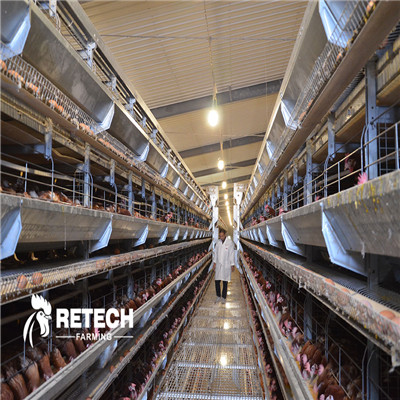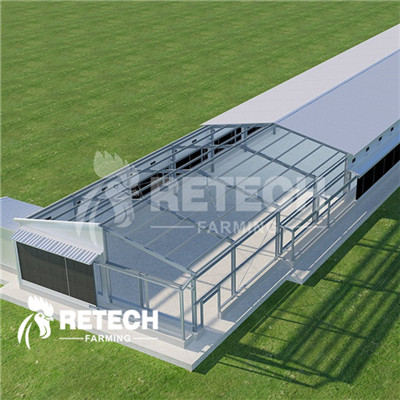घर में एक अच्छा माइक्रोक्लाइमेट बच्चों की परवरिश की कुंजी है।बैटरी चिकन पिंजरेअंडे देने वाली मुर्गियाँ। घर में सूक्ष्म जलवायु का मतलब है कि घर में वायु वातावरण नियंत्रण योग्य है।
घर में सूक्ष्म जलवायु क्या है? घर में सूक्ष्म जलवायु से तात्पर्य तापमान, आर्द्रता और वायु-संचार के प्रबंधन से है ताकि मुर्गी घर के लिए एक अच्छा, छोटा वातावरण बनाया जा सके जो बाहरी दुनिया से प्रभावित न हो और युवा मुर्गियों के विकास के लिए उपयुक्त हो। यह छोटा वातावरण ही घर में सूक्ष्म जलवायु है।
घर में सूक्ष्म जलवायु नियंत्रण से तात्पर्य घर में तापमान, आर्द्रता और वायु-संचार के बीच संबंधों को नियंत्रित करने से है। युवा मुर्गियों के पालन-पोषण और प्रबंधन के लिए, उचित तापमान नियंत्रण की स्थिति में आर्द्रता और वायु-संचार के बीच संबंधों का समन्वय आवश्यक है।
एक अच्छा तरीका यह है कि पूरे अवधि के दैनिक तापमान वक्र को मानक मानकर, दैनिक अधिकतम तापमान मान और न्यूनतम तापमान मान निर्धारित करें, और अधिकतम तापमान मान और न्यूनतम तापमान मान के आधार पर दो वक्र बनाएँ। तापमान को न्यूनतम तापमान वक्र के भीतर नियंत्रित किया जाता है। फिर न्यूनतम वेंटिलेशन प्रबंधन विधि निर्धारित करें। आर्द्रता नियंत्रण वक्र भी उसी समय निर्धारित किया जाना चाहिए।
इसकी मुख्य विशेषताएंबैटरी चिकन पिंजरेमुर्गी घर:
1. ऊपरी और निचली परतों के बीच तापमान के अंतर की समस्या का समाधान ज़रूरी है। ऊपरी और निचली परतों के बीच तापमान के अंतर का समाधान छत के बीच में एक डायवर्जन फ़ैन लगाना है।मुर्गी घर, जो 1 के भीतर परतों के बीच तापमान अंतर को नियंत्रित कर सकता है°C.
2. मुर्गीघर के बीच में मुर्गियों को ऑक्सीजन की आपूर्ति पर्याप्त है या नहीं, यह प्रश्न। मध्यवर्ती ऑक्सीजन आपूर्ति में सुधार का प्रभावी उपाय वायु प्रवेश द्वार की वायु वेग और एकसमान वायु खिड़की है। साथ ही, ठंडी हवा को वायु वेग से होने वाले नुकसान से बचाना भी आवश्यक है।बैटरी पिंजरे में बंद मुर्गियाँदोनों तरफ़। निवारक उपाय एक विक्षेपक का उपयोग करना है, ताकि ठंडी हवा को ऊपर और नीचे बहने पर गलियारे में गिरने से नियंत्रित किया जा सके, ताकि पर्याप्त ऑक्सीजन मध्य पिंजरे तक पहुँच सके और पर्याप्त ऑक्सीजन की आपूर्ति सुनिश्चित हो सके।
3.स्थिर और संतुलित नकारात्मक दबाव वेंटिलेशन एक चिकन पालन की सफलता या विफलता की कुंजी है।बैटरी चिकन पिंजरेचिकन हाउस, और यह मध्य पिंजरे में ऑक्सीजन की आपूर्ति और पिंजरे के दोनों तरफ ठंडी हवा की सुरक्षा के लिए एक महत्वपूर्ण उपाय भी है।
नकारात्मक दबाव वेंटिलेशन के दो कार्य हैं:
एक यह है कि चिकन हाउस के बीच में पर्याप्त ऑक्सीजन की आपूर्ति सुनिश्चित की जाए, नकारात्मक दबाव हवा के इनलेट की हवा की गति निर्धारित करता है, और हवा के इनलेट की हवा की गति मध्य पिंजरे में पर्याप्त ऑक्सीजन की आपूर्ति निर्धारित करती है।
दूसरा यह सुनिश्चित करना है कि मुर्गी घर में हवा ताज़ा रहे। नकारात्मक दबाव वेंटिलेशन एक वेंटिलेशन विधि है जो पहले गंदी हवा को बाहर निकालती है, और फिर ताज़ी हवा अंदर आती है, ताकि मुर्गी घर में हवा का प्रभावी ढंग से संचार हो सके।
4.बैटरी चिकन पिंजरेमुर्गी घर के वेंटिलेशन मोड पर बहुत प्रभाव पड़ेगा। जैसे पिंजरे की दूरी, पक्षियों का घनत्व और वजन, घर की चौड़ाई और लंबाई का अनुपात, मुर्गी की नस्लें आदि वेंटिलेशन पैटर्न को बदल देंगी। मानकीकृत घर में भी, हर घर का वेंटिलेशन एक जैसा नहीं होता।
घर में सूक्ष्म जलवायु कैसी है?
घर में सूक्ष्म जलवायु से तात्पर्य तापमान, आर्द्रता और वायु-संचार के प्रबंधन से है ताकि मुर्गी घर के लिए एक अच्छा, छोटा वातावरण बनाया जा सके जो बाहरी दुनिया से प्रभावित न हो और युवा मुर्गियों के विकास के लिए उपयुक्त हो। यह छोटा वातावरण ही घर में सूक्ष्म जलवायु है।
घर में सूक्ष्म जलवायु नियंत्रण से तात्पर्य घर में तापमान, आर्द्रता और वायु-संचार के बीच संबंधों को नियंत्रित करने से है। युवा मुर्गियों के पालन-पोषण और प्रबंधन के लिए, उचित तापमान नियंत्रण की स्थिति में आर्द्रता और वायु-संचार के बीच संबंधों का समन्वय आवश्यक है।
एक अच्छा तरीका यह है कि पूरे अवधि के दैनिक तापमान वक्र को मानक मानकर, दैनिक अधिकतम तापमान मान और न्यूनतम तापमान मान निर्धारित करें, और अधिकतम तापमान मान और न्यूनतम तापमान मान के आधार पर दो वक्र बनाएँ। तापमान को न्यूनतम तापमान वक्र के भीतर नियंत्रित किया जाता है। फिर न्यूनतम वेंटिलेशन प्रबंधन विधि निर्धारित करें। आर्द्रता नियंत्रण वक्र भी उसी समय निर्धारित किया जाना चाहिए।
पोस्ट करने का समय: 17 मई 2022










